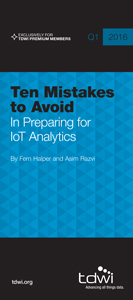
Ten Mistakes to Avoid In Preparing for IoT Analytics
TDWI Member Exclusive
March 7, 2016
By Fern Halper and Asim Razvi
The Internet of Things (IoT)—a network of connected devices that can send and receive data over the Internet—is a hot market topic. Analysts predict there will be tens of billions of these devices by 2020. They’ll be in the home and in office buildings; you’ll be wearing them for your health and wellness. They will be in your cars, in factories, and on farms. The idea is not new. Machine-to-machine (M2M) applications have been around for decades doing things such as monitoring temperature and pressure. It was a limited set of problems often using proprietary protocols.
A number of factors have come together to make the time right for IoT. These include the low cost of computers, storage, and bandwidth; the availability of high-speed networks; low-power semiconductors; and low-cost devices for Wi-Fi and Internet access. Additional factors include the maturing of more advanced technologies such as artificial intelligence, machine learning, and robotics.
TDWI research indicates that interest in IoT is growing. If users stick to their plans, there will be numerous IoT deployments in the coming years. These will be used for medical alerts, preventive maintenance to improve operations, precision farming, and a host of other applications. Although many companies are excited about the possibility of improving operational efficiencies and driving new business models with IoT, there are a number of mistakes to avoid when getting ready for IoT analytics projects. These often revolve around assembling the right team, getting buy-in, and understanding what is different about IoT analytics.